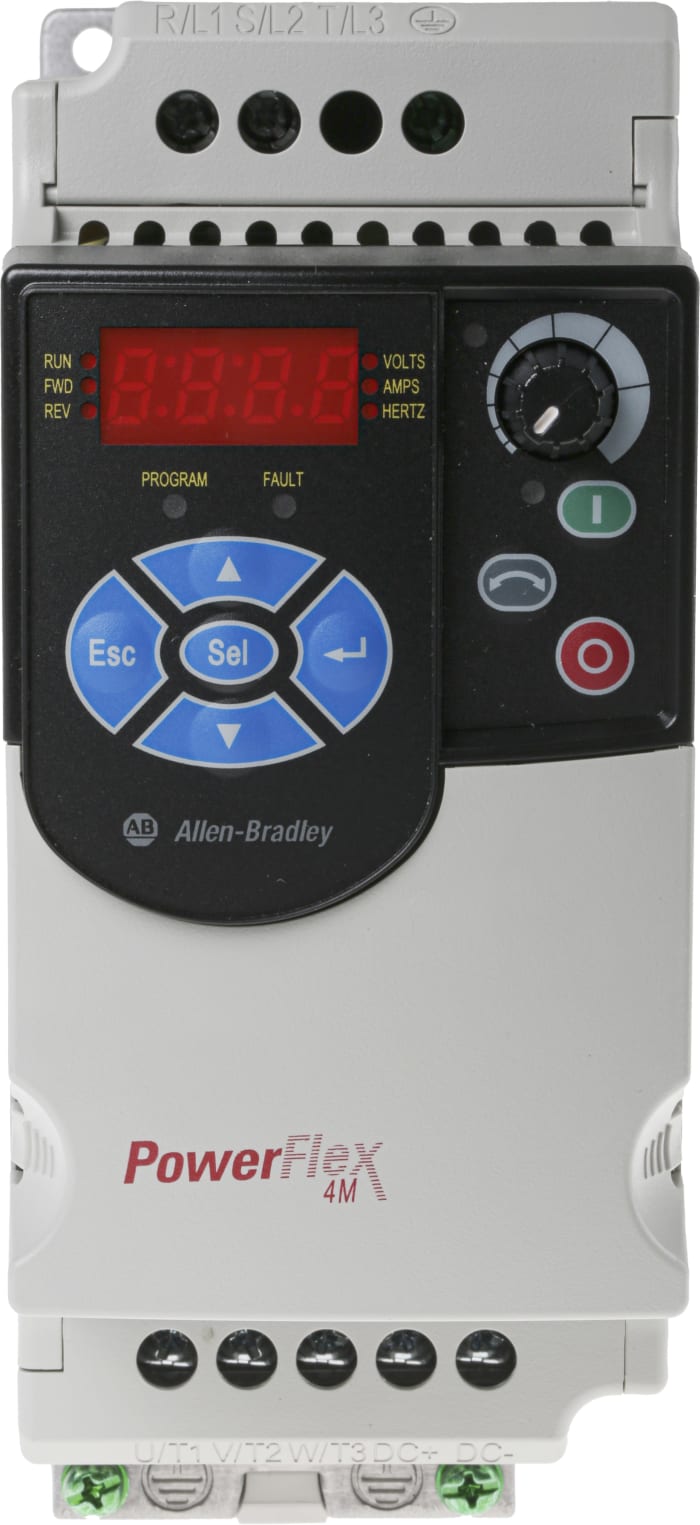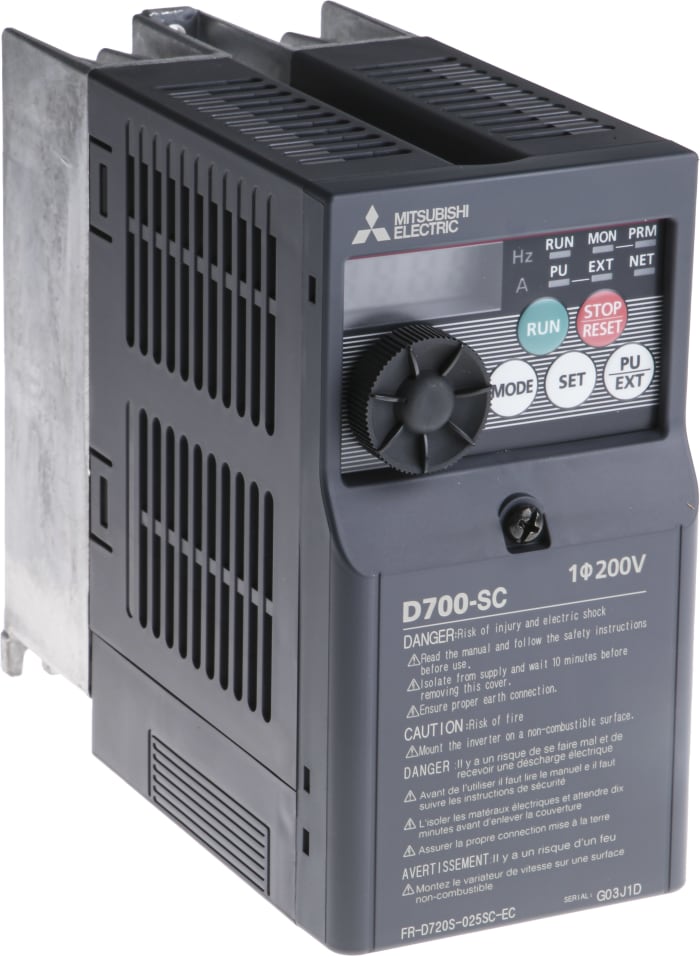Technical documents
Specifications
Brand
Allen BradleyPower Rating
0.4 kW
Phase
1
Supply Voltage
240 V ac
Current Rating
2.5 A
For Use With
AC Motors
Series
PowerFlex 4M
Field Bus Communication Type
ModBus
IP Rating
IP20
Output Frequency
400Hz
STO
No
Mounting Type
Panel Mount
Control Panel
Yes
Overall Length
174mm
Overall Width
72mm
Overall Depth
136mm
Country of Origin
Taiwan, Province Of China
Product details
Allen Bradley PowerFlex 4M Single-Phase Input Frequency Controllers
Experience powerful and precise motor speed control with PowerFlex 4M Single-Phase Input Frequency Controllers by Allen Bradley. These compact, cost-effective inverter drives are perfectly suited for machine level control. PowerFlex 4M drives offer application flexibility, feed through wiring and ease-of-programming to provide you with a streamlined and highly efficient motor control solution.
This drive is available in three frame sizes: A, B, and C, with power ratings from 0.2 to 11 kW (0.25 to 15 Hp) and in voltage classes of 120, 240 and 480 volts. Its ventilation system is only activated during motor operation, and it is silent when stopped, ensuring long service life.
Features and Benefits:
• Pulse Width Modulation Frequency adjustable to 10 kHz for quiet operation
• DIN rail mounting feature on A and B frame drives
• Integral keypad included
• Ambient temperatures up to 50 °C (122 °F) permitted with minimal spacing between drives
• Side-by-side Zero Stacking™ Drives for ambient temperatures up to 40 °C (104 °F)
• Integral RS-485 communications
• Ingress Protection level of IP20 with open type enclosure and slip compensation for enhanced stability
•Drive overload protection and ramp regulation
What is an Inverter Drive?
An Inverter Drive (also known as AC Drive, Variable Frequency Drive, or VFD) is a motor drive device which regulates the amount of power supplied to a motor, allowing for precise control of speed or torque to the motor to suit its application. They are situated between an electrical supply and a motor. Electrical motors run many things we use in our society today and inverter drives are used for speed control in a range of applications, such as simple fan and pump loads. Inverter drives are also used widely in industrial applications for high torque machine control. Most inverter drives now have features such as digital operation and LED displays allowing for easy set-up, monitoring, and adjustment of parameters by the user.
How does an Inverter Drive work?
Inverter drives are controlled by inputting specific frequencies or parameters into the device. When power goes through the drive the inverter adjusts the frequency and voltage that is supplied to the motor. They ensure that an electrical motor receives only the necessary amount of power it requires to function, in order to reduce waste or loss of electrical energy, thereby making it more efficient to run. They can also gradually ramp up power for a slower, safer machine start up. Inside the inverter, incoming AC power is converted to DC power via a rectifier made up of diodes, which is then smoothed to a clean, constant voltage by capacitors, and is then fed back out as AC power via output transistors.


P.O.A.
1
P.O.A.
1
Stock information temporarily unavailable.
Please check again later.


Technical documents
Specifications
Brand
Allen BradleyPower Rating
0.4 kW
Phase
1
Supply Voltage
240 V ac
Current Rating
2.5 A
For Use With
AC Motors
Series
PowerFlex 4M
Field Bus Communication Type
ModBus
IP Rating
IP20
Output Frequency
400Hz
STO
No
Mounting Type
Panel Mount
Control Panel
Yes
Overall Length
174mm
Overall Width
72mm
Overall Depth
136mm
Country of Origin
Taiwan, Province Of China
Product details
Allen Bradley PowerFlex 4M Single-Phase Input Frequency Controllers
Experience powerful and precise motor speed control with PowerFlex 4M Single-Phase Input Frequency Controllers by Allen Bradley. These compact, cost-effective inverter drives are perfectly suited for machine level control. PowerFlex 4M drives offer application flexibility, feed through wiring and ease-of-programming to provide you with a streamlined and highly efficient motor control solution.
This drive is available in three frame sizes: A, B, and C, with power ratings from 0.2 to 11 kW (0.25 to 15 Hp) and in voltage classes of 120, 240 and 480 volts. Its ventilation system is only activated during motor operation, and it is silent when stopped, ensuring long service life.
Features and Benefits:
• Pulse Width Modulation Frequency adjustable to 10 kHz for quiet operation
• DIN rail mounting feature on A and B frame drives
• Integral keypad included
• Ambient temperatures up to 50 °C (122 °F) permitted with minimal spacing between drives
• Side-by-side Zero Stacking™ Drives for ambient temperatures up to 40 °C (104 °F)
• Integral RS-485 communications
• Ingress Protection level of IP20 with open type enclosure and slip compensation for enhanced stability
•Drive overload protection and ramp regulation
What is an Inverter Drive?
An Inverter Drive (also known as AC Drive, Variable Frequency Drive, or VFD) is a motor drive device which regulates the amount of power supplied to a motor, allowing for precise control of speed or torque to the motor to suit its application. They are situated between an electrical supply and a motor. Electrical motors run many things we use in our society today and inverter drives are used for speed control in a range of applications, such as simple fan and pump loads. Inverter drives are also used widely in industrial applications for high torque machine control. Most inverter drives now have features such as digital operation and LED displays allowing for easy set-up, monitoring, and adjustment of parameters by the user.
How does an Inverter Drive work?
Inverter drives are controlled by inputting specific frequencies or parameters into the device. When power goes through the drive the inverter adjusts the frequency and voltage that is supplied to the motor. They ensure that an electrical motor receives only the necessary amount of power it requires to function, in order to reduce waste or loss of electrical energy, thereby making it more efficient to run. They can also gradually ramp up power for a slower, safer machine start up. Inside the inverter, incoming AC power is converted to DC power via a rectifier made up of diodes, which is then smoothed to a clean, constant voltage by capacitors, and is then fed back out as AC power via output transistors.


